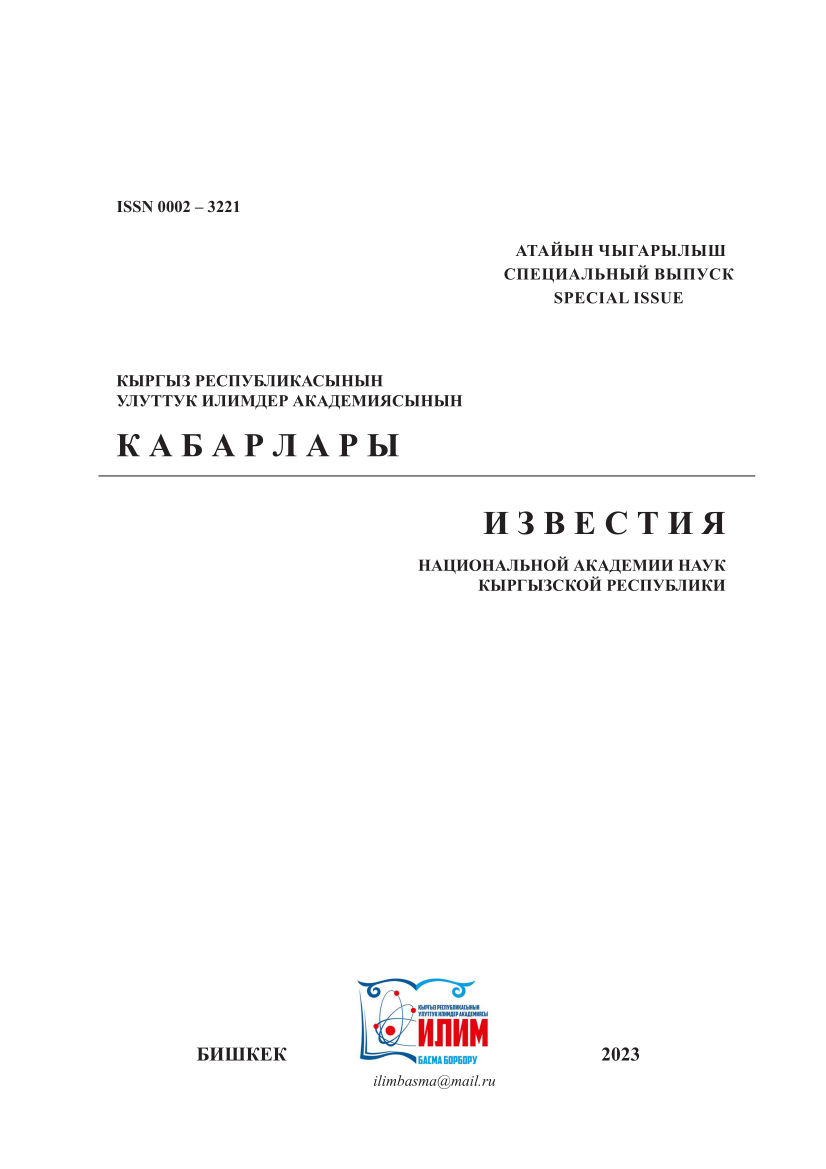PHYSICAL-CHEMICAL AND THERMODYNAMIC CHARACTERISTICS OF KAOLIN CLAY OF THE CHOKO-BULAK DEPOSIT AT DIFFERENT TEMPERATURES DESTRUCTION
Keywords:
kaolin, clay, destruction, oxide, hydroxide, aluminum.Abstract
The chemical matrix of unfired kaolin clay from the Choko-Bulak deposit was compiled and thermodynamic modeling of its destruction was carried out over a wide range of temperature changes. The physicochemical and thermodynamic parameters of a multicomponent complex clay system were calculated. The concentration distribution of Al, Si, Fe, Ca, Mg, H, O-containing components, active particles and condensed phases at the maximum entropy of the system has been established. Temperature limits for the formation and transformation of various aluminum-containing substances have been identified.
References
Liu, C., Huang, Y., Wang, X., Zhu, Z., Yu, M., Bu, C., & Zhang, J. Interactions of PbCl2 capture and CdCl2 capture by kaolin in the high-temperature PbCl2-CdCl2-Kaolin reaction system. Fuel, 2021, 286, 119346. doi:10.1016/j.fuel.2020.119346
De Souza Lima, J., Boemo, A. P. S. I., de Araújo, P. H. H., & de Oliveira, D. Immobilization of endoglucanase on kaolin by adsorption and covalent bonding. Bioprocess and Biosystems Eng. 2021, doi:10.1007/s00449-021-02545-3
Wang, H., Dong, Y., Zhu, M., Li, X., Keller, A. A., Wang, T., & Li, F. Heteroaggregation of engineered nanoparticles and kaolin clays in aqueous environments. Water Research, 2015, 80, 130–138. doi:10.1016/j.watres.2015.05.023
Wang, S., Nan, Z., Li, Y., & Zhao, Z. The chemical bonding of copper ions on kaolin from Suzhou, China. Desalination, 2009, 249(3), 991–995. doi:10.1016/j.desal.2009.09.017
Arias, M., Barral, M. T., & Mejuto, J. C.Enhancement of copper and cadmium adsorption on kaolin by the presence of humic acids. Chemosphere, 2002, 48(10), 1081–1088. doi:10.1016/s0045-6535(02)00169-8
Tang, Q., Tang, X., Li, Z., Chen, Y., Kou, N., & Sun, Z. Adsorption and desorption behaviour of Pb(II) on a natural kaolin: equilibrium, kinetic and thermodynamic studies. Journal of Chemical Technology & Biotechnology, 2009, 84(9), 1371–1380. doi:10.1002/jctb.2192
Wang, H., Li, C., Peng, Z., & Zhang, S. Characterization and thermal behavior of kaolin. Journal of Thermal Analysis and Calorimetry, 2011, 105(1), 157–160. doi:10.1007/s10973-011-1385-0
Shahverdi-Shahraki, K., Ghosh, T., Mahajan, K., Ajji, A., & Carreau, P. J. Effect of dry grinding on chemically modified kaolin. Applied Clay Science, 2015, 105-106, 100–106. doi:10.1016/j.clay.2014.12.026
Zaman, A. A., Tsuchiya, R., & Moudgil, B. M. Adsorption of a Low-Molecular-Weight Polyacrylic Acid on Silica, Alumina, and Kaolin. Journal of Colloid and Interface Science, 2002, 256(1), 73–78. doi:10.1006/jcis.2001.7941
Yanik, G. Mineralogical, crystallographic and technological characteristics of Yaylayolu kaolin (Kütahya, Turkey). Clay Minerals, 2011, 46(03), 397–410. doi:10.1180/claymin.2011.046.3.397
Кенжаев М.Э., Исламова М.Ш., Мирзакулов Х.Ч. Исследование влияния процесса прокалки на извлечение окиси алюминия из ангренских каолинов-Universum: технические науки- электрон. науч.журн. 2017, №4(37)
Лайнер Ю. А. «Комплексная переработка алюминийсодержащего сырья кислотными методами». Москва: Наука, 1982. – 208 с.
Панов А.А. «Состояние и перспективы развития кислотных способов получения глинозема». Материалы международной конференции «Цветные металлы – 2012». Красноярск, 2012. – С. 272-277.

